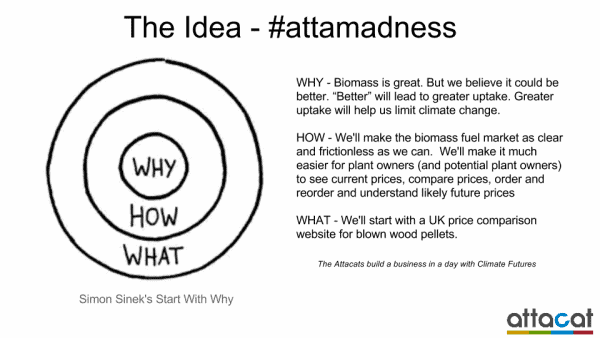It’s been just over a month since we used Leap Day (29th February) for our #attamadness “build a business in a day” challenge. It’s obviously been exciting but it’s also been an incredible learning experience.
The TL:DR version of this article is that we’ve quickly and inexpensively learned that the business model is going to need a little bit of a tweak and we are therefore on the road to achieving great things!
Where’s The Woodpicker now?
Since the #attamadness launch day, TheWoodpicker.com has been in the capable hands of Juliet with direction from Charlie. Thanks to messing my knee up on day one of my skiing holiday, I’ve also been able to put the odd hour in here and there too. The social side of things is also beginning to grow, with the launch of a Facebook and Twitter discussion, which we hope to make a monthly thing to bring together suppliers and customers to discuss the issues and questions they may have.
Here’s an interview we did for The Scotsman TV one week after the launch
https://www.youtube.com/watch?list=PLl-Rj1kcCvWQ51r1jxsDjQxzhnlMAEBfH&v=0s7R2N4QAjw
Since then we’ve:
- passed the 100 customer* mark (who we estimate represents around £300,000 worth of annual pellet consumption)
- Built a grandly named “quote management system” – basically a reasonably sophisticated Google spreadsheet (with my personal highlight being the script that I managed to cut and paste to automatically calculate distance between two postcodes)
- Almost got a bank account set-up (yet we’ve still been able to take payments using GoCardless for direct debit)
- Sent our first newsletter
- Most importantly we’ve:
- learned what customers and suppliers don’t want
- continued to talk to a lot of customers and suppliers
What about the money?
We have processed some but it’s fair to say we’ve got a long way to go before we can include the word “profit” in our management accounts! Just because we’ve described people who have used our service as customers, doesn’t mean there isn’t a lot to do before we will be able to describe these people as repeat, loyal customers.
The most important bit of the accounts, though, is that we’ve also spent very little, meaning we still have money in the bank (or “runway” as a start-up would describe it).
Main lessons learned
The disciplines being forced on us as a result of the “business in a day” format has been an incredible learning experience. We jumped in at the deep end and now have no choice but to swim. That means procrastinating or doing it all myself (often my default position!) are just not options. That is incredibly liberating!
The approach has also made the ideas behind “agile” and “lean start-up” very real for me and that is a lesson that will be invaluable for developing Attacat as well as for working with clients to help them achieve their goals.
I suspect that when people first hear the start-up mantra of “fail quickly”, they think of major disaster followed by consoling yourself that at least you won’t make that mistake again.
However, that could not be further from the truth. The first month of The Woodpicker has shown me that the mantra is far more about learning rapidly that some things do not pan out exactly as you might expect. If I was to describe that as “failure” it would be very misleading as actually we have made a huge leap forward.
 The iteration of The Woodpicker we launched on February 29th was entirely based on what we thought customers and suppliers would want. Turns out, it’s not that simple. A few do want what we’re offering and a good number don’t (at least not in its current form). We haven’t yet achieved the level of customer delight that I thought we would.
The iteration of The Woodpicker we launched on February 29th was entirely based on what we thought customers and suppliers would want. Turns out, it’s not that simple. A few do want what we’re offering and a good number don’t (at least not in its current form). We haven’t yet achieved the level of customer delight that I thought we would.
I view this as a real positive though. If we’d done it the traditional way, we would still be debating the wording on the website and building a back-end system to automate the business process and probably still be three months away from getting any real customers to use the system. We would have spent more and learned nothing.
Instead, we built the simplest system we could that allowed customers to interact with us and one month in we’ve learned a huge amount from those customers. Our “price comparison search engine for wood pellet fuel” may only have been a website form. It really hasn’t mattered that our “back-end” was not a nice efficient bit of software (instead it was Juliet literally ringing round the suppliers to get prices and then emailing the information to the customers!). What matters is it has been sufficient to learn a huge amount from real customers.
In lean startup terms we’ve run our first experiment, and are now ready for our next one. And here are the real positives of this approach:
- We’ve got lots of ideas we wouldn’t have had otherwise.
- We’ve demonstrated that there is a real demand for “something” in this space and have started to build up a database of those who are looking for this “something”.
- We’ve saved ourselves a fortune already (as in, we haven’t wasted money developing the wrong product, which now means we still have money to spend)
Going forward, our next “experiment” will also take a “lean” approach. At this point, we think we know what customers will want. We now need to work out what the “minimum viable product” is to determine if this second hypothesis is right, or, most likely, whether it too will need some tweaking.
If we go back to the original “start with why” we set out a month ago, that vision is as strong as ever.
It may be that the “what” is going to be slightly tweaked as a result of what we’ve learned this month, but the “why” and “how” are totally unchanged and indeed our confidence that we are on the right track has been bolstered by getting into the market place quicker than perhaps we even thought was practical.
If you would like to discuss how these “lean” approaches could help you achieve your digital goals, please do get in touch or feel free to share your own experiences in the comments below.


